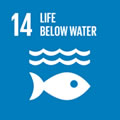Por favor, use este identificador para citar o enlazar a este item:
http://hdl.handle.net/10261/309140COMPARTIR / EXPORTAR:
 SHARE
BASE SHARE
BASE
|
|
| Visualizar otros formatos: MARC | Dublin Core | RDF | ORE | MODS | METS | DIDL | DATACITE | |

| Título: | Effects of the submarine emission from a volcano in marine zooplankton revealed by carbon isotopes |
Autor: | Herrera, Inmaculada; Fraile-Nuez, Eugenio ; González-Ortegón, Enrique CSIC ORCID | Palabras clave: | Biomarkers Good environmental status Marine Strategies Sustainable development Goal 14 Zooplankton |
Fecha de publicación: | 6-jul-2022 | Citación: | VIII International Symposium on Marine Sciences (2022) | Resumen: | On October 10, 2011, the underwater volcano, Tagoro, erupted in the south of the island of El Hierro (Canary Islands), Atlantic Ocean. This eruption had consequences, causing physical and chemical changes (Fraile Nuez et al., 2012; Santana-Casiano et al., 2013; 2016) in the water column resulting in alterations to the distribution of the pelagic fauna (Ariza et al., 2014) during the first stage of the volcano, and variations in the structure of the zooplankton community in the following post-eruptive stages between 2013 and 2018 (Fernández de Puelles et al., 2021). In addition, this eruption could have altered the local carbon and nitrogen cycle due to changes in nutrient concentrations, which affect phytoplankton growth, and the isotopic signatures of zooplankton. These responses were measured during the post-eruptive phase using the stable isotope δ13C and δ15N. An increase in CO2 alters the response of isotopic fractionation in plankton across a CO2 gradient (Witkowski et al., 2020). A high-resolution study was conducted across 15 stations along the Tagoro volcano, separated into four zones of volcanic influence on zooplankton. We focus on the two most abundant taxonomic groups, Chaetognatha and Copepoda as predator and prey respectively in the second level of the marine food web. Significant spatial differences were found in these secondary consumers of plankton. These differences are explained mainly by an increase in the carbon isotopic signature of copepods between the Tagoro Vulcano (zone 1) to the most distant zone (zone 4) of the area studied for Copepods, and mainly in the species of the genera Nasutus sp. and Sewelli sp. This is consistent with the idea that CO2 concentrations have an important effect on isotopic fractionation, with an δ13C enrichment of ca. 2‰ from the volcano to the control area. This baseline information plays an important role in addressing gaps in the knowledge concerning the objectives to be implemented in the current Marine Strategy Framework Directive, as well as Sustainable Objective 14, Life Under Water. | Descripción: | Trabajo presentado en el VIII International Symposium on Marine Sciences (ISMS 2022), celebrado en Las Palmas de Gran Canaria (España) entre el 6 y el 8 de mayo de 2022. | URI: | http://hdl.handle.net/10261/309140 |
| Aparece en las colecciones: | (ICMAN) Comunicaciones congresos |
Ficheros en este ítem:
| Fichero | Descripción | Tamaño | Formato | |
|---|---|---|---|---|
| accesoRestringido.pdf | 15,38 kB | Adobe PDF |  Visualizar/Abrir |
CORE Recommender
NOTA: Los ítems de Digital.CSIC están protegidos por copyright, con todos los derechos reservados, a menos que se indique lo contrario.


